Risk Analysis Report: Risk Management Plan for MacVille Toowoomba
VerifiedAdded on 2020/05/16
|16
|3802
|82
Report
AI Summary
This report details a risk management assessment for MacVille's new outlet in Toowoomba, Australia. The report begins with an overview of risk management principles, goals, and objectives, referencing AS/NZS ISO 31000:2009 and MacVille's policy. It outlines the scope of risk management and identifies both internal and external stakeholders. The analysis employs SWOT and PESTEL frameworks to evaluate the new branch's strengths, weaknesses, opportunities, and threats, as well as political, economic, social, technological, environmental, and legal factors. The report summarizes key risk factors and emphasizes the importance of accountability, continuous improvement, and stakeholder communication. It includes an email correspondence to the CEO summarizing the findings and recommendations based on site visits and stakeholder consultations, identifying potential risks such as banking, travel, and compliance issues. The report then presents a risk analysis, detailing specific threats to MacVille's business expansion, along with proposed mitigation strategies for each identified risk. It includes recommendations for addressing banking practices, travel safety, and regulatory compliance to ensure the successful launch and operation of the Toowoomba store.
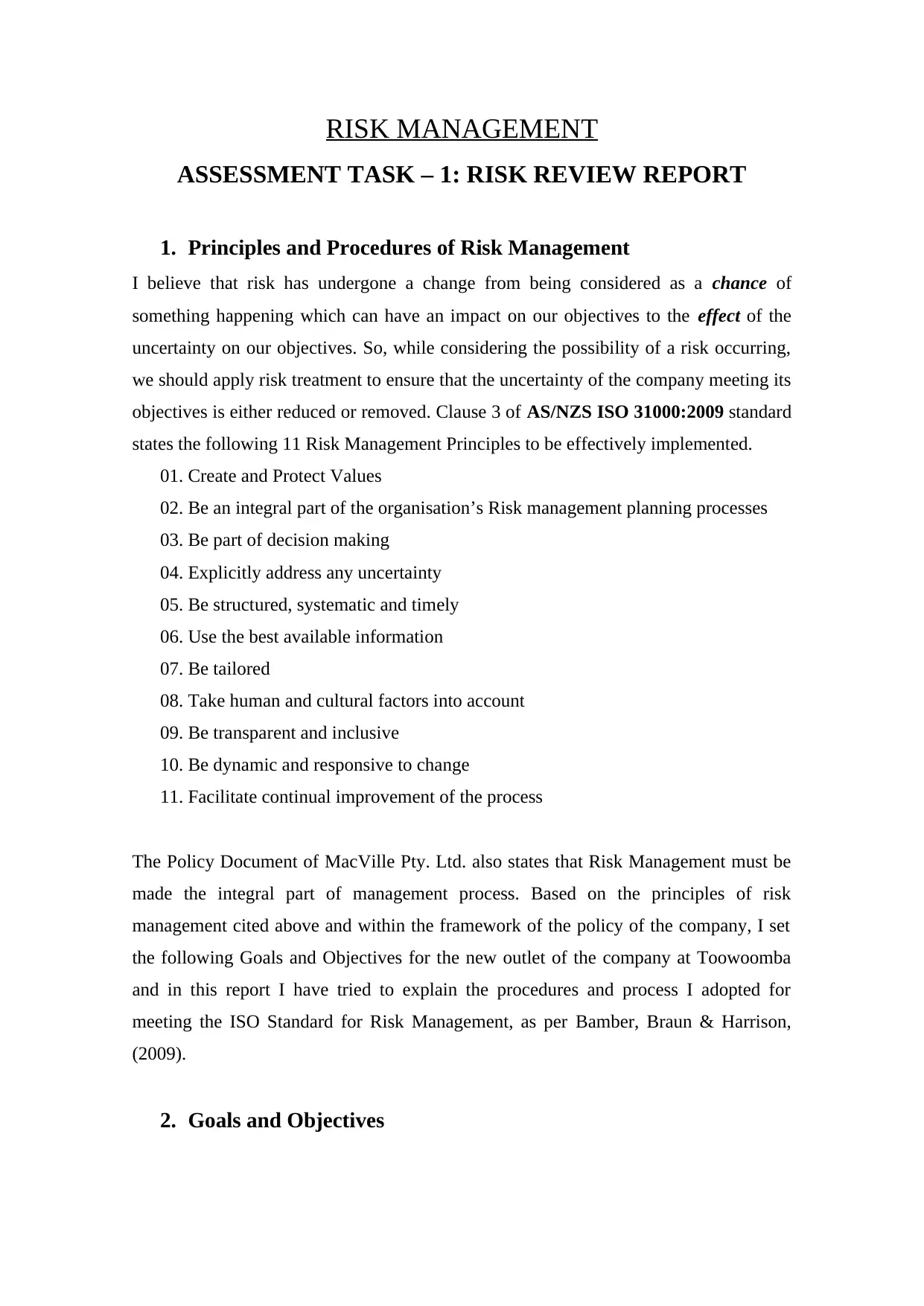
RISK MANAGEMENT
ASSESSMENT TASK – 1: RISK REVIEW REPORT
1. Principles and Procedures of Risk Management
I believe that risk has undergone a change from being considered as a chance of
something happening which can have an impact on our objectives to the effect of the
uncertainty on our objectives. So, while considering the possibility of a risk occurring,
we should apply risk treatment to ensure that the uncertainty of the company meeting its
objectives is either reduced or removed. Clause 3 of AS/NZS ISO 31000:2009 standard
states the following 11 Risk Management Principles to be effectively implemented.
01. Create and Protect Values
02. Be an integral part of the organisation’s Risk management planning processes
03. Be part of decision making
04. Explicitly address any uncertainty
05. Be structured, systematic and timely
06. Use the best available information
07. Be tailored
08. Take human and cultural factors into account
09. Be transparent and inclusive
10. Be dynamic and responsive to change
11. Facilitate continual improvement of the process
The Policy Document of MacVille Pty. Ltd. also states that Risk Management must be
made the integral part of management process. Based on the principles of risk
management cited above and within the framework of the policy of the company, I set
the following Goals and Objectives for the new outlet of the company at Toowoomba
and in this report I have tried to explain the procedures and process I adopted for
meeting the ISO Standard for Risk Management, as per Bamber, Braun & Harrison,
(2009).
2. Goals and Objectives
ASSESSMENT TASK – 1: RISK REVIEW REPORT
1. Principles and Procedures of Risk Management
I believe that risk has undergone a change from being considered as a chance of
something happening which can have an impact on our objectives to the effect of the
uncertainty on our objectives. So, while considering the possibility of a risk occurring,
we should apply risk treatment to ensure that the uncertainty of the company meeting its
objectives is either reduced or removed. Clause 3 of AS/NZS ISO 31000:2009 standard
states the following 11 Risk Management Principles to be effectively implemented.
01. Create and Protect Values
02. Be an integral part of the organisation’s Risk management planning processes
03. Be part of decision making
04. Explicitly address any uncertainty
05. Be structured, systematic and timely
06. Use the best available information
07. Be tailored
08. Take human and cultural factors into account
09. Be transparent and inclusive
10. Be dynamic and responsive to change
11. Facilitate continual improvement of the process
The Policy Document of MacVille Pty. Ltd. also states that Risk Management must be
made the integral part of management process. Based on the principles of risk
management cited above and within the framework of the policy of the company, I set
the following Goals and Objectives for the new outlet of the company at Toowoomba
and in this report I have tried to explain the procedures and process I adopted for
meeting the ISO Standard for Risk Management, as per Bamber, Braun & Harrison,
(2009).
2. Goals and Objectives
Paraphrase This Document
Need a fresh take? Get an instant paraphrase of this document with our AI Paraphraser
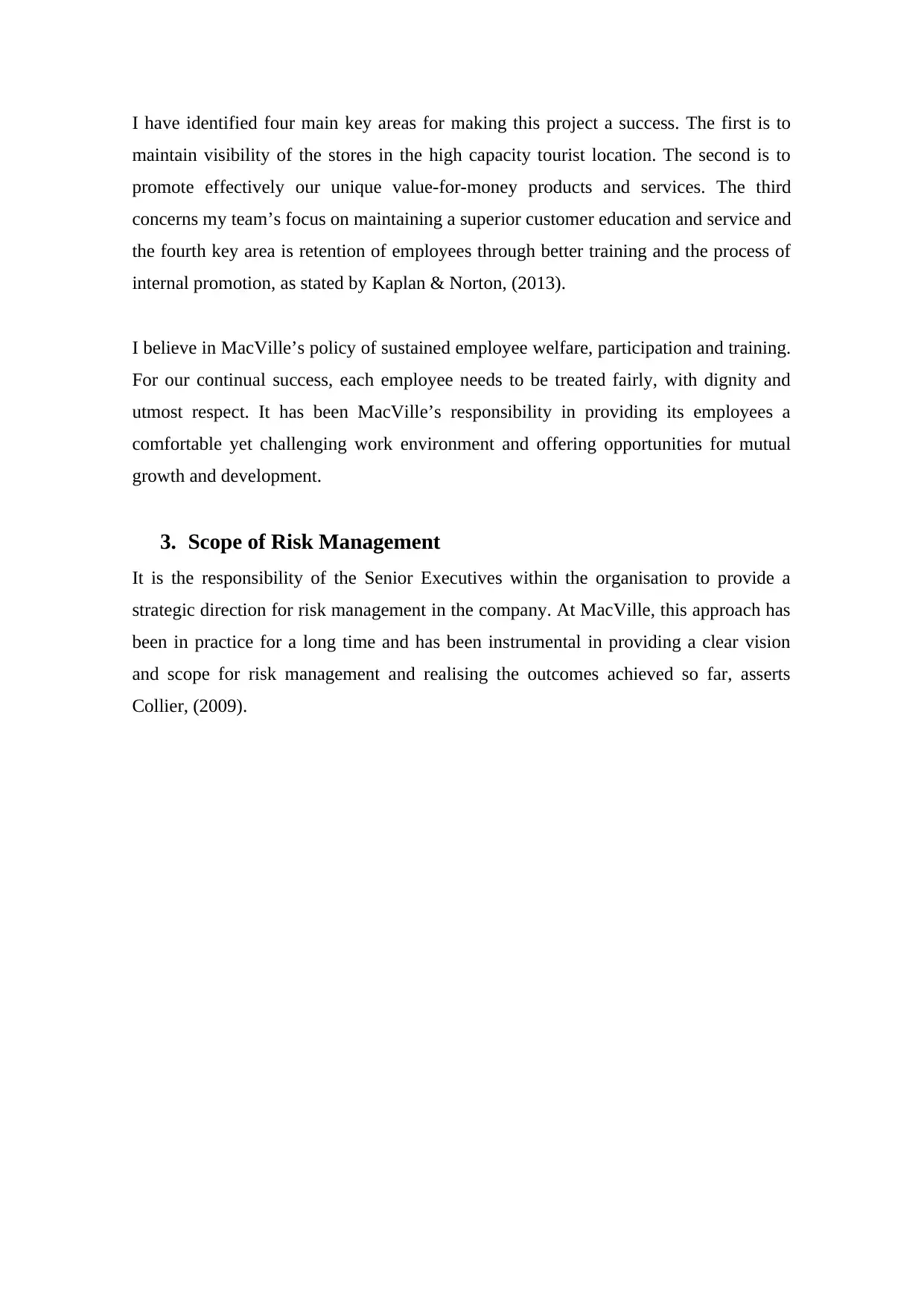
I have identified four main key areas for making this project a success. The first is to
maintain visibility of the stores in the high capacity tourist location. The second is to
promote effectively our unique value-for-money products and services. The third
concerns my team’s focus on maintaining a superior customer education and service and
the fourth key area is retention of employees through better training and the process of
internal promotion, as stated by Kaplan & Norton, (2013).
I believe in MacVille’s policy of sustained employee welfare, participation and training.
For our continual success, each employee needs to be treated fairly, with dignity and
utmost respect. It has been MacVille’s responsibility in providing its employees a
comfortable yet challenging work environment and offering opportunities for mutual
growth and development.
3. Scope of Risk Management
It is the responsibility of the Senior Executives within the organisation to provide a
strategic direction for risk management in the company. At MacVille, this approach has
been in practice for a long time and has been instrumental in providing a clear vision
and scope for risk management and realising the outcomes achieved so far, asserts
Collier, (2009).
maintain visibility of the stores in the high capacity tourist location. The second is to
promote effectively our unique value-for-money products and services. The third
concerns my team’s focus on maintaining a superior customer education and service and
the fourth key area is retention of employees through better training and the process of
internal promotion, as stated by Kaplan & Norton, (2013).
I believe in MacVille’s policy of sustained employee welfare, participation and training.
For our continual success, each employee needs to be treated fairly, with dignity and
utmost respect. It has been MacVille’s responsibility in providing its employees a
comfortable yet challenging work environment and offering opportunities for mutual
growth and development.
3. Scope of Risk Management
It is the responsibility of the Senior Executives within the organisation to provide a
strategic direction for risk management in the company. At MacVille, this approach has
been in practice for a long time and has been instrumental in providing a clear vision
and scope for risk management and realising the outcomes achieved so far, asserts
Collier, (2009).
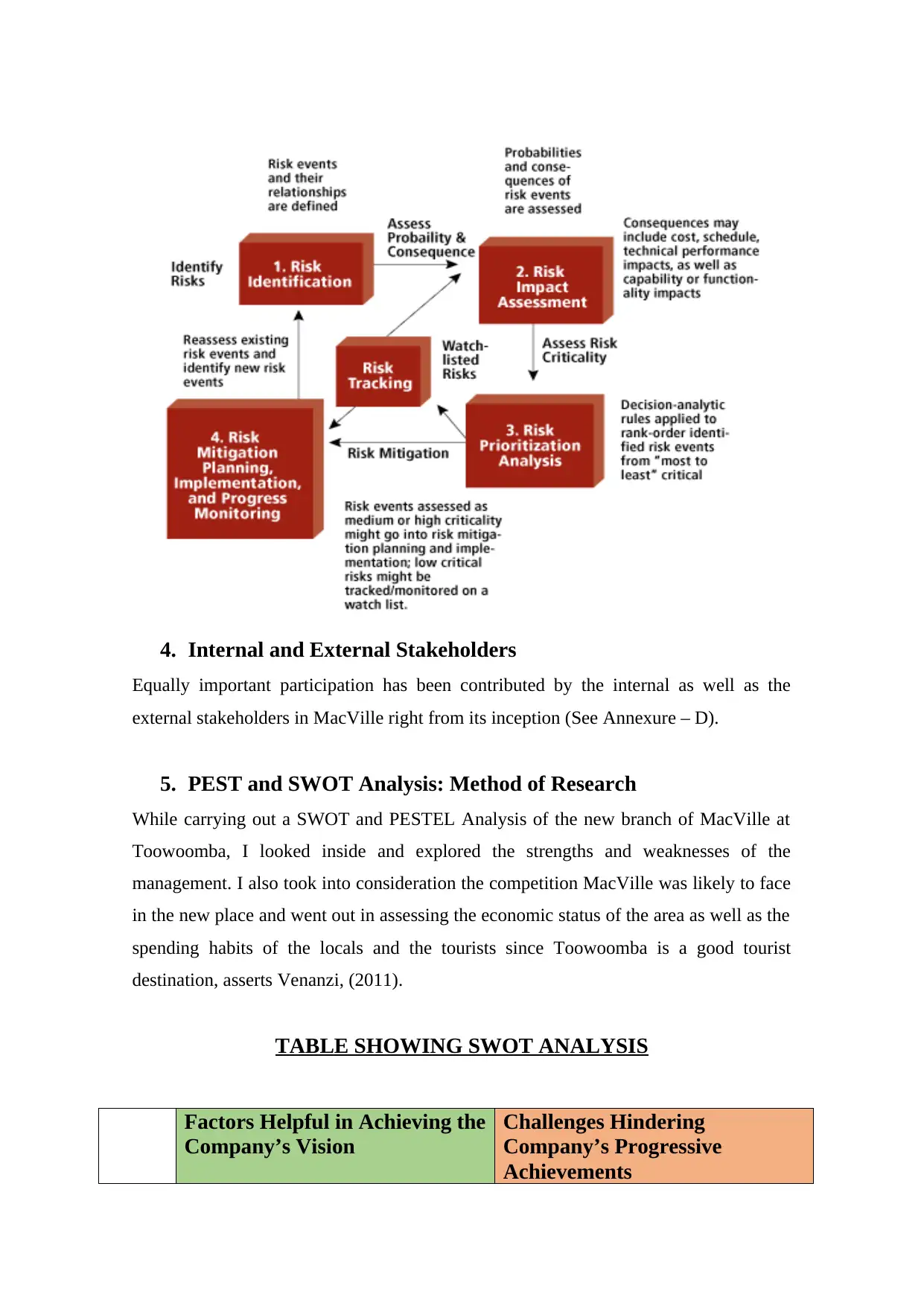
4. Internal and External Stakeholders
Equally important participation has been contributed by the internal as well as the
external stakeholders in MacVille right from its inception (See Annexure – D).
5. PEST and SWOT Analysis: Method of Research
While carrying out a SWOT and PESTEL Analysis of the new branch of MacVille at
Toowoomba, I looked inside and explored the strengths and weaknesses of the
management. I also took into consideration the competition MacVille was likely to face
in the new place and went out in assessing the economic status of the area as well as the
spending habits of the locals and the tourists since Toowoomba is a good tourist
destination, asserts Venanzi, (2011).
TABLE SHOWING SWOT ANALYSIS
Factors Helpful in Achieving the
Company’s Vision
Challenges Hindering
Company’s Progressive
Achievements
Equally important participation has been contributed by the internal as well as the
external stakeholders in MacVille right from its inception (See Annexure – D).
5. PEST and SWOT Analysis: Method of Research
While carrying out a SWOT and PESTEL Analysis of the new branch of MacVille at
Toowoomba, I looked inside and explored the strengths and weaknesses of the
management. I also took into consideration the competition MacVille was likely to face
in the new place and went out in assessing the economic status of the area as well as the
spending habits of the locals and the tourists since Toowoomba is a good tourist
destination, asserts Venanzi, (2011).
TABLE SHOWING SWOT ANALYSIS
Factors Helpful in Achieving the
Company’s Vision
Challenges Hindering
Company’s Progressive
Achievements
⊘ This is a preview!⊘
Do you want full access?
Subscribe today to unlock all pages.

Trusted by 1+ million students worldwide
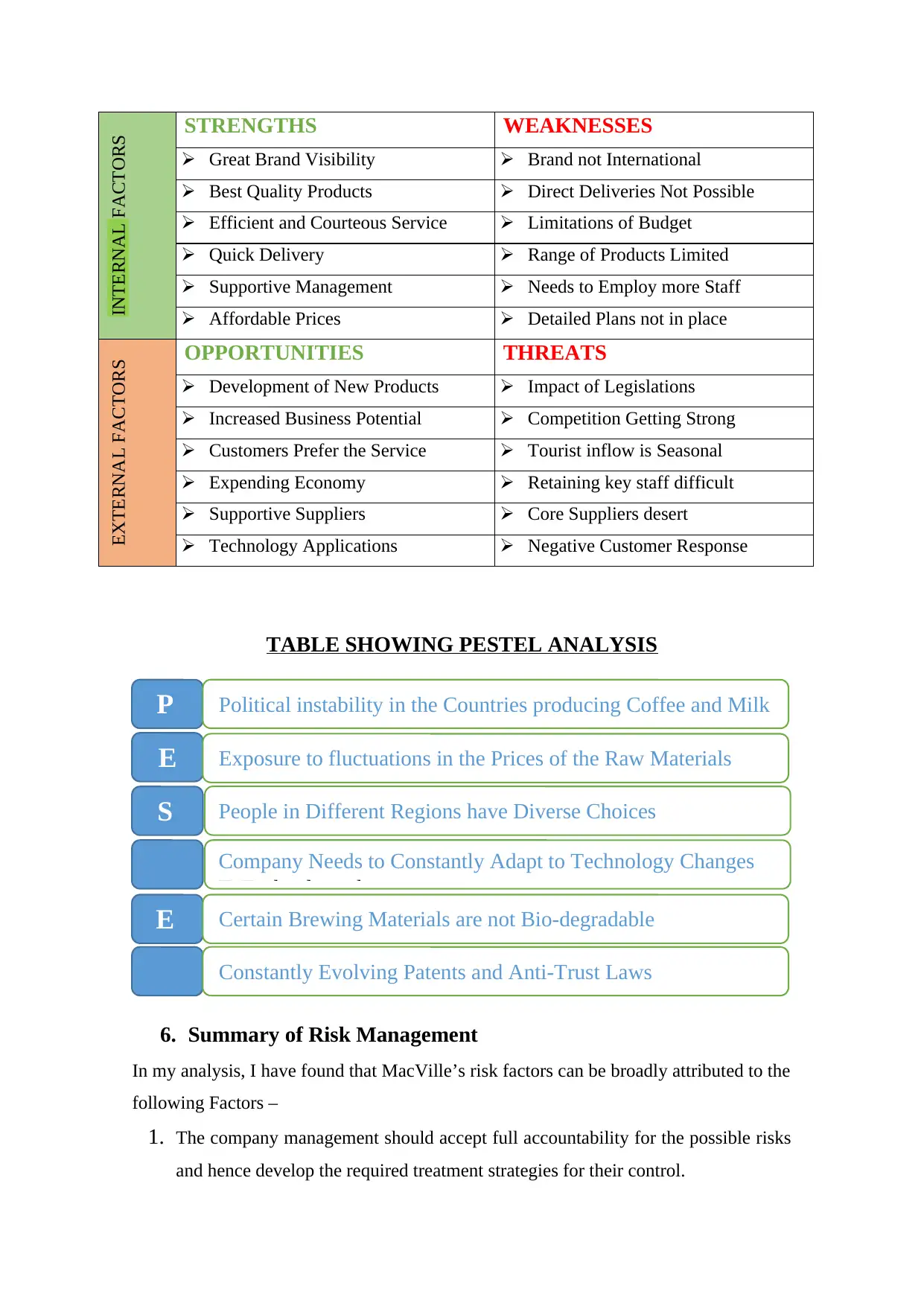
INTERNAL FACTORS STRENGTHS WEAKNESSES
Great Brand Visibility Brand not International
Best Quality Products Direct Deliveries Not Possible
Efficient and Courteous Service Limitations of Budget
Quick Delivery Range of Products Limited
Supportive Management Needs to Employ more Staff
Affordable Prices Detailed Plans not in place
EXTERNAL FACTORS OPPORTUNITIES THREATS
Development of New Products Impact of Legislations
Increased Business Potential Competition Getting Strong
Customers Prefer the Service Tourist inflow is Seasonal
Expending Economy Retaining key staff difficult
Supportive Suppliers Core Suppliers desert
Technology Applications Negative Customer Response
TABLE SHOWING PESTEL ANALYSIS
6. Summary of Risk Management
In my analysis, I have found that MacVille’s risk factors can be broadly attributed to the
following Factors –
1. The company management should accept full accountability for the possible risks
and hence develop the required treatment strategies for their control.
P Political instability in the Countries producing Coffee and Milk
E Exposure to fluctuations in the Prices of the Raw Materials
S People in Different Regions have Diverse Choices
TCompany Needs to Constantly Adapt to Technology Changes
TeTechnolorends
E Certain Brewing Materials are not Bio-degradable
LConstantly Evolving Patents and Anti-Trust Laws
Great Brand Visibility Brand not International
Best Quality Products Direct Deliveries Not Possible
Efficient and Courteous Service Limitations of Budget
Quick Delivery Range of Products Limited
Supportive Management Needs to Employ more Staff
Affordable Prices Detailed Plans not in place
EXTERNAL FACTORS OPPORTUNITIES THREATS
Development of New Products Impact of Legislations
Increased Business Potential Competition Getting Strong
Customers Prefer the Service Tourist inflow is Seasonal
Expending Economy Retaining key staff difficult
Supportive Suppliers Core Suppliers desert
Technology Applications Negative Customer Response
TABLE SHOWING PESTEL ANALYSIS
6. Summary of Risk Management
In my analysis, I have found that MacVille’s risk factors can be broadly attributed to the
following Factors –
1. The company management should accept full accountability for the possible risks
and hence develop the required treatment strategies for their control.
P Political instability in the Countries producing Coffee and Milk
E Exposure to fluctuations in the Prices of the Raw Materials
S People in Different Regions have Diverse Choices
TCompany Needs to Constantly Adapt to Technology Changes
TeTechnolorends
E Certain Brewing Materials are not Bio-degradable
LConstantly Evolving Patents and Anti-Trust Laws
Paraphrase This Document
Need a fresh take? Get an instant paraphrase of this document with our AI Paraphraser
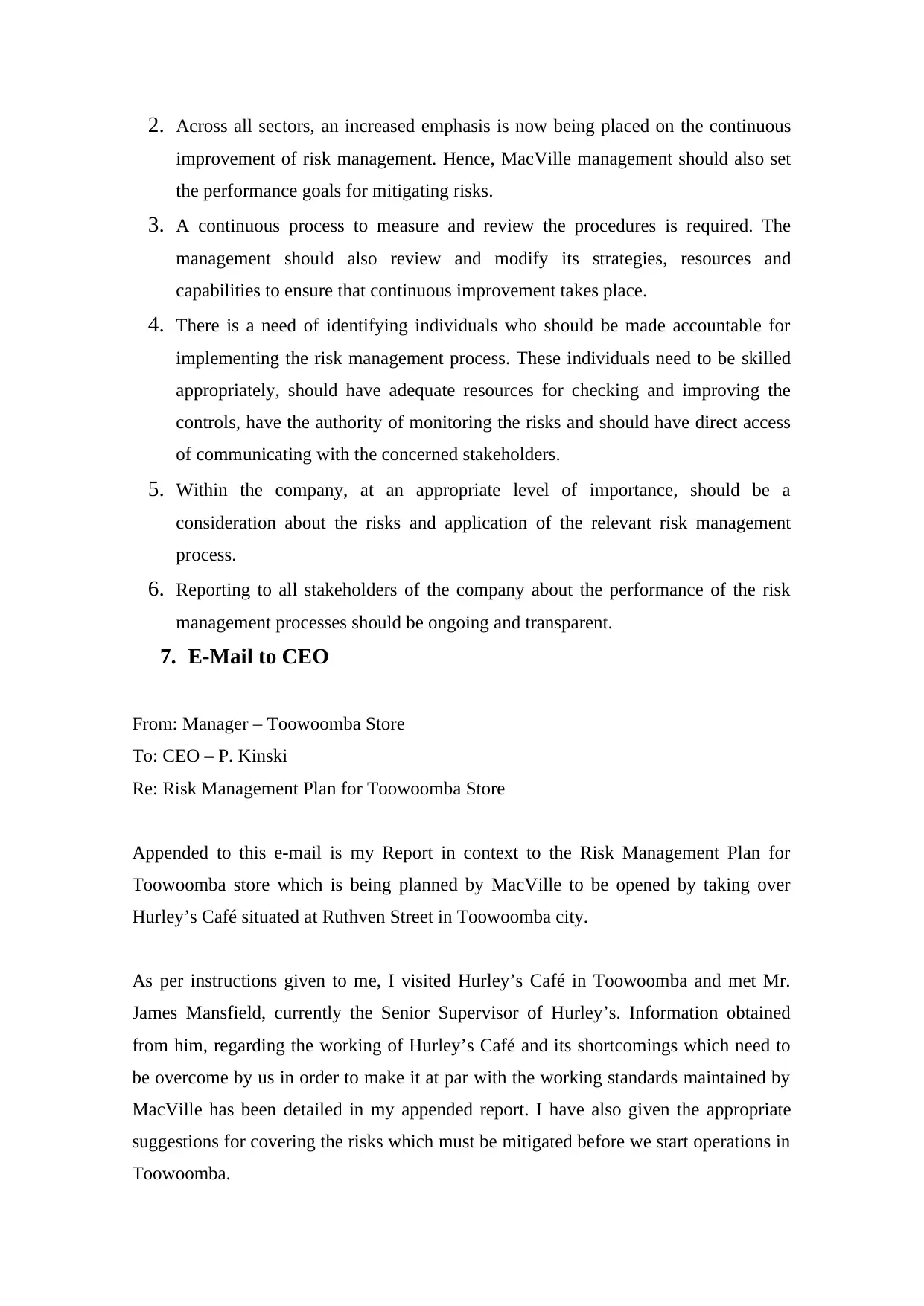
2. Across all sectors, an increased emphasis is now being placed on the continuous
improvement of risk management. Hence, MacVille management should also set
the performance goals for mitigating risks.
3. A continuous process to measure and review the procedures is required. The
management should also review and modify its strategies, resources and
capabilities to ensure that continuous improvement takes place.
4. There is a need of identifying individuals who should be made accountable for
implementing the risk management process. These individuals need to be skilled
appropriately, should have adequate resources for checking and improving the
controls, have the authority of monitoring the risks and should have direct access
of communicating with the concerned stakeholders.
5. Within the company, at an appropriate level of importance, should be a
consideration about the risks and application of the relevant risk management
process.
6. Reporting to all stakeholders of the company about the performance of the risk
management processes should be ongoing and transparent.
7. E-Mail to CEO
From: Manager – Toowoomba Store
To: CEO – P. Kinski
Re: Risk Management Plan for Toowoomba Store
Appended to this e-mail is my Report in context to the Risk Management Plan for
Toowoomba store which is being planned by MacVille to be opened by taking over
Hurley’s Café situated at Ruthven Street in Toowoomba city.
As per instructions given to me, I visited Hurley’s Café in Toowoomba and met Mr.
James Mansfield, currently the Senior Supervisor of Hurley’s. Information obtained
from him, regarding the working of Hurley’s Café and its shortcomings which need to
be overcome by us in order to make it at par with the working standards maintained by
MacVille has been detailed in my appended report. I have also given the appropriate
suggestions for covering the risks which must be mitigated before we start operations in
Toowoomba.
improvement of risk management. Hence, MacVille management should also set
the performance goals for mitigating risks.
3. A continuous process to measure and review the procedures is required. The
management should also review and modify its strategies, resources and
capabilities to ensure that continuous improvement takes place.
4. There is a need of identifying individuals who should be made accountable for
implementing the risk management process. These individuals need to be skilled
appropriately, should have adequate resources for checking and improving the
controls, have the authority of monitoring the risks and should have direct access
of communicating with the concerned stakeholders.
5. Within the company, at an appropriate level of importance, should be a
consideration about the risks and application of the relevant risk management
process.
6. Reporting to all stakeholders of the company about the performance of the risk
management processes should be ongoing and transparent.
7. E-Mail to CEO
From: Manager – Toowoomba Store
To: CEO – P. Kinski
Re: Risk Management Plan for Toowoomba Store
Appended to this e-mail is my Report in context to the Risk Management Plan for
Toowoomba store which is being planned by MacVille to be opened by taking over
Hurley’s Café situated at Ruthven Street in Toowoomba city.
As per instructions given to me, I visited Hurley’s Café in Toowoomba and met Mr.
James Mansfield, currently the Senior Supervisor of Hurley’s. Information obtained
from him, regarding the working of Hurley’s Café and its shortcomings which need to
be overcome by us in order to make it at par with the working standards maintained by
MacVille has been detailed in my appended report. I have also given the appropriate
suggestions for covering the risks which must be mitigated before we start operations in
Toowoomba.
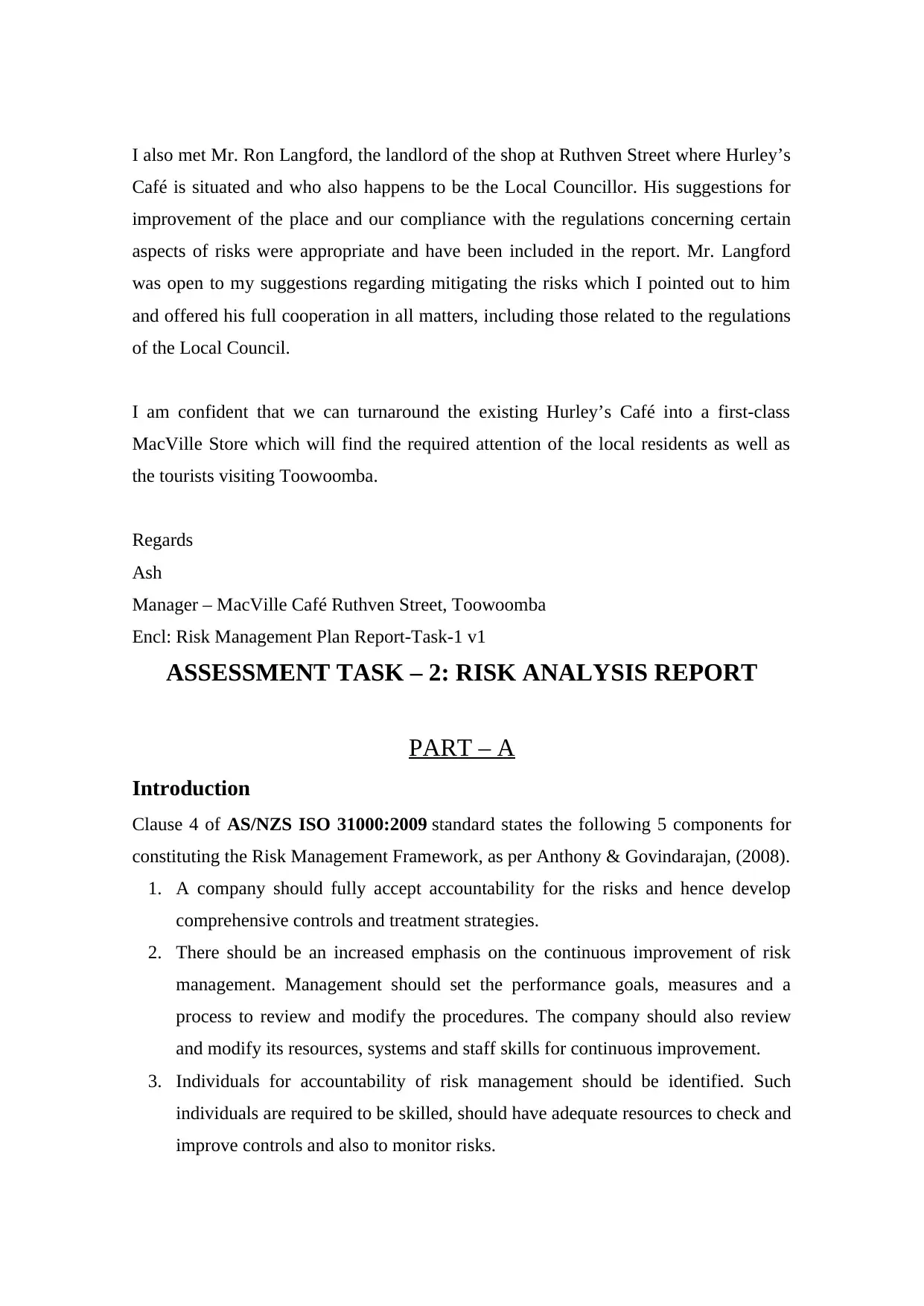
I also met Mr. Ron Langford, the landlord of the shop at Ruthven Street where Hurley’s
Café is situated and who also happens to be the Local Councillor. His suggestions for
improvement of the place and our compliance with the regulations concerning certain
aspects of risks were appropriate and have been included in the report. Mr. Langford
was open to my suggestions regarding mitigating the risks which I pointed out to him
and offered his full cooperation in all matters, including those related to the regulations
of the Local Council.
I am confident that we can turnaround the existing Hurley’s Café into a first-class
MacVille Store which will find the required attention of the local residents as well as
the tourists visiting Toowoomba.
Regards
Ash
Manager – MacVille Café Ruthven Street, Toowoomba
Encl: Risk Management Plan Report-Task-1 v1
ASSESSMENT TASK – 2: RISK ANALYSIS REPORT
PART – A
Introduction
Clause 4 of AS/NZS ISO 31000:2009 standard states the following 5 components for
constituting the Risk Management Framework, as per Anthony & Govindarajan, (2008).
1. A company should fully accept accountability for the risks and hence develop
comprehensive controls and treatment strategies.
2. There should be an increased emphasis on the continuous improvement of risk
management. Management should set the performance goals, measures and a
process to review and modify the procedures. The company should also review
and modify its resources, systems and staff skills for continuous improvement.
3. Individuals for accountability of risk management should be identified. Such
individuals are required to be skilled, should have adequate resources to check and
improve controls and also to monitor risks.
Café is situated and who also happens to be the Local Councillor. His suggestions for
improvement of the place and our compliance with the regulations concerning certain
aspects of risks were appropriate and have been included in the report. Mr. Langford
was open to my suggestions regarding mitigating the risks which I pointed out to him
and offered his full cooperation in all matters, including those related to the regulations
of the Local Council.
I am confident that we can turnaround the existing Hurley’s Café into a first-class
MacVille Store which will find the required attention of the local residents as well as
the tourists visiting Toowoomba.
Regards
Ash
Manager – MacVille Café Ruthven Street, Toowoomba
Encl: Risk Management Plan Report-Task-1 v1
ASSESSMENT TASK – 2: RISK ANALYSIS REPORT
PART – A
Introduction
Clause 4 of AS/NZS ISO 31000:2009 standard states the following 5 components for
constituting the Risk Management Framework, as per Anthony & Govindarajan, (2008).
1. A company should fully accept accountability for the risks and hence develop
comprehensive controls and treatment strategies.
2. There should be an increased emphasis on the continuous improvement of risk
management. Management should set the performance goals, measures and a
process to review and modify the procedures. The company should also review
and modify its resources, systems and staff skills for continuous improvement.
3. Individuals for accountability of risk management should be identified. Such
individuals are required to be skilled, should have adequate resources to check and
improve controls and also to monitor risks.
⊘ This is a preview!⊘
Do you want full access?
Subscribe today to unlock all pages.

Trusted by 1+ million students worldwide
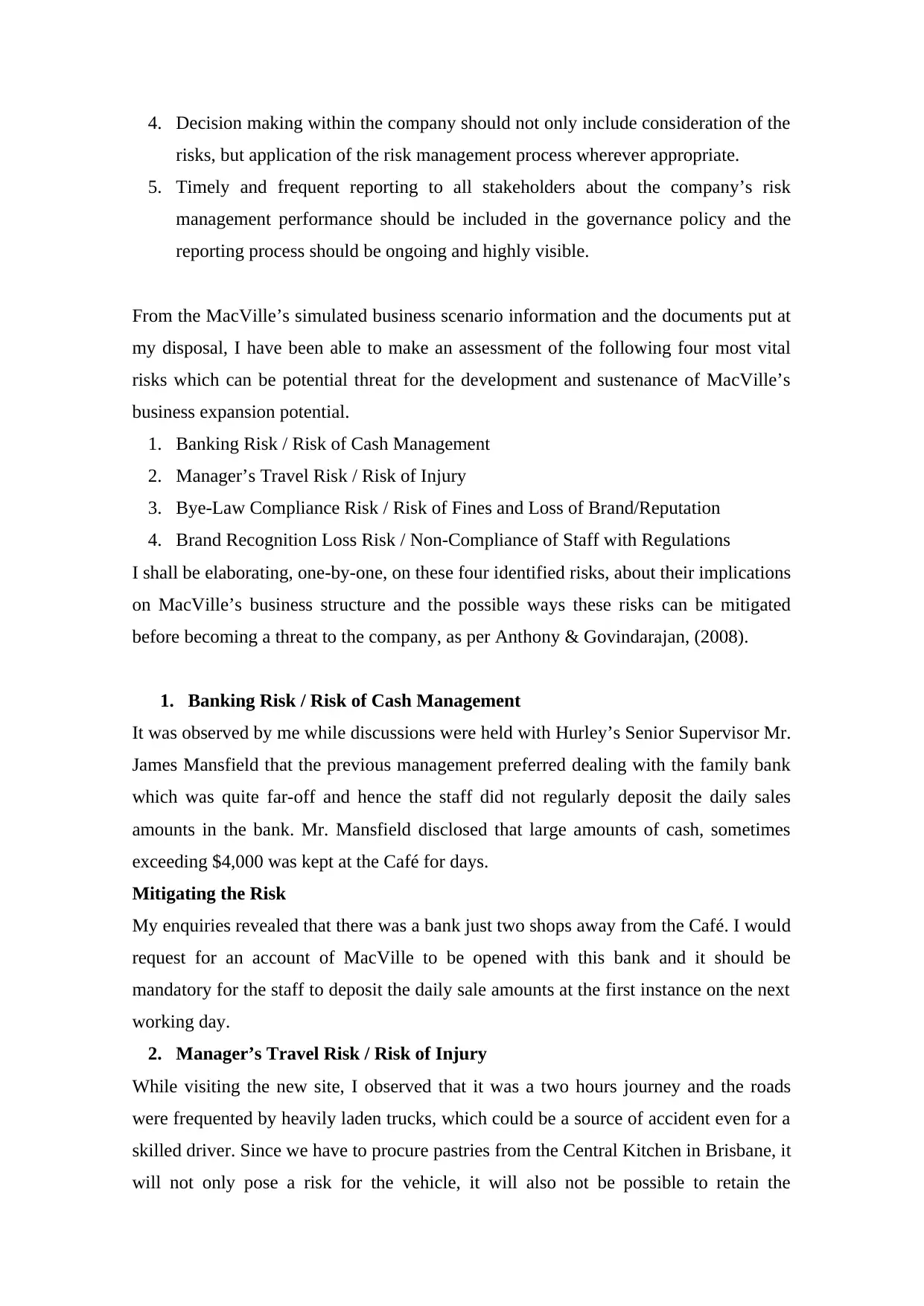
4. Decision making within the company should not only include consideration of the
risks, but application of the risk management process wherever appropriate.
5. Timely and frequent reporting to all stakeholders about the company’s risk
management performance should be included in the governance policy and the
reporting process should be ongoing and highly visible.
From the MacVille’s simulated business scenario information and the documents put at
my disposal, I have been able to make an assessment of the following four most vital
risks which can be potential threat for the development and sustenance of MacVille’s
business expansion potential.
1. Banking Risk / Risk of Cash Management
2. Manager’s Travel Risk / Risk of Injury
3. Bye-Law Compliance Risk / Risk of Fines and Loss of Brand/Reputation
4. Brand Recognition Loss Risk / Non-Compliance of Staff with Regulations
I shall be elaborating, one-by-one, on these four identified risks, about their implications
on MacVille’s business structure and the possible ways these risks can be mitigated
before becoming a threat to the company, as per Anthony & Govindarajan, (2008).
1. Banking Risk / Risk of Cash Management
It was observed by me while discussions were held with Hurley’s Senior Supervisor Mr.
James Mansfield that the previous management preferred dealing with the family bank
which was quite far-off and hence the staff did not regularly deposit the daily sales
amounts in the bank. Mr. Mansfield disclosed that large amounts of cash, sometimes
exceeding $4,000 was kept at the Café for days.
Mitigating the Risk
My enquiries revealed that there was a bank just two shops away from the Café. I would
request for an account of MacVille to be opened with this bank and it should be
mandatory for the staff to deposit the daily sale amounts at the first instance on the next
working day.
2. Manager’s Travel Risk / Risk of Injury
While visiting the new site, I observed that it was a two hours journey and the roads
were frequented by heavily laden trucks, which could be a source of accident even for a
skilled driver. Since we have to procure pastries from the Central Kitchen in Brisbane, it
will not only pose a risk for the vehicle, it will also not be possible to retain the
risks, but application of the risk management process wherever appropriate.
5. Timely and frequent reporting to all stakeholders about the company’s risk
management performance should be included in the governance policy and the
reporting process should be ongoing and highly visible.
From the MacVille’s simulated business scenario information and the documents put at
my disposal, I have been able to make an assessment of the following four most vital
risks which can be potential threat for the development and sustenance of MacVille’s
business expansion potential.
1. Banking Risk / Risk of Cash Management
2. Manager’s Travel Risk / Risk of Injury
3. Bye-Law Compliance Risk / Risk of Fines and Loss of Brand/Reputation
4. Brand Recognition Loss Risk / Non-Compliance of Staff with Regulations
I shall be elaborating, one-by-one, on these four identified risks, about their implications
on MacVille’s business structure and the possible ways these risks can be mitigated
before becoming a threat to the company, as per Anthony & Govindarajan, (2008).
1. Banking Risk / Risk of Cash Management
It was observed by me while discussions were held with Hurley’s Senior Supervisor Mr.
James Mansfield that the previous management preferred dealing with the family bank
which was quite far-off and hence the staff did not regularly deposit the daily sales
amounts in the bank. Mr. Mansfield disclosed that large amounts of cash, sometimes
exceeding $4,000 was kept at the Café for days.
Mitigating the Risk
My enquiries revealed that there was a bank just two shops away from the Café. I would
request for an account of MacVille to be opened with this bank and it should be
mandatory for the staff to deposit the daily sale amounts at the first instance on the next
working day.
2. Manager’s Travel Risk / Risk of Injury
While visiting the new site, I observed that it was a two hours journey and the roads
were frequented by heavily laden trucks, which could be a source of accident even for a
skilled driver. Since we have to procure pastries from the Central Kitchen in Brisbane, it
will not only pose a risk for the vehicle, it will also not be possible to retain the
Paraphrase This Document
Need a fresh take? Get an instant paraphrase of this document with our AI Paraphraser
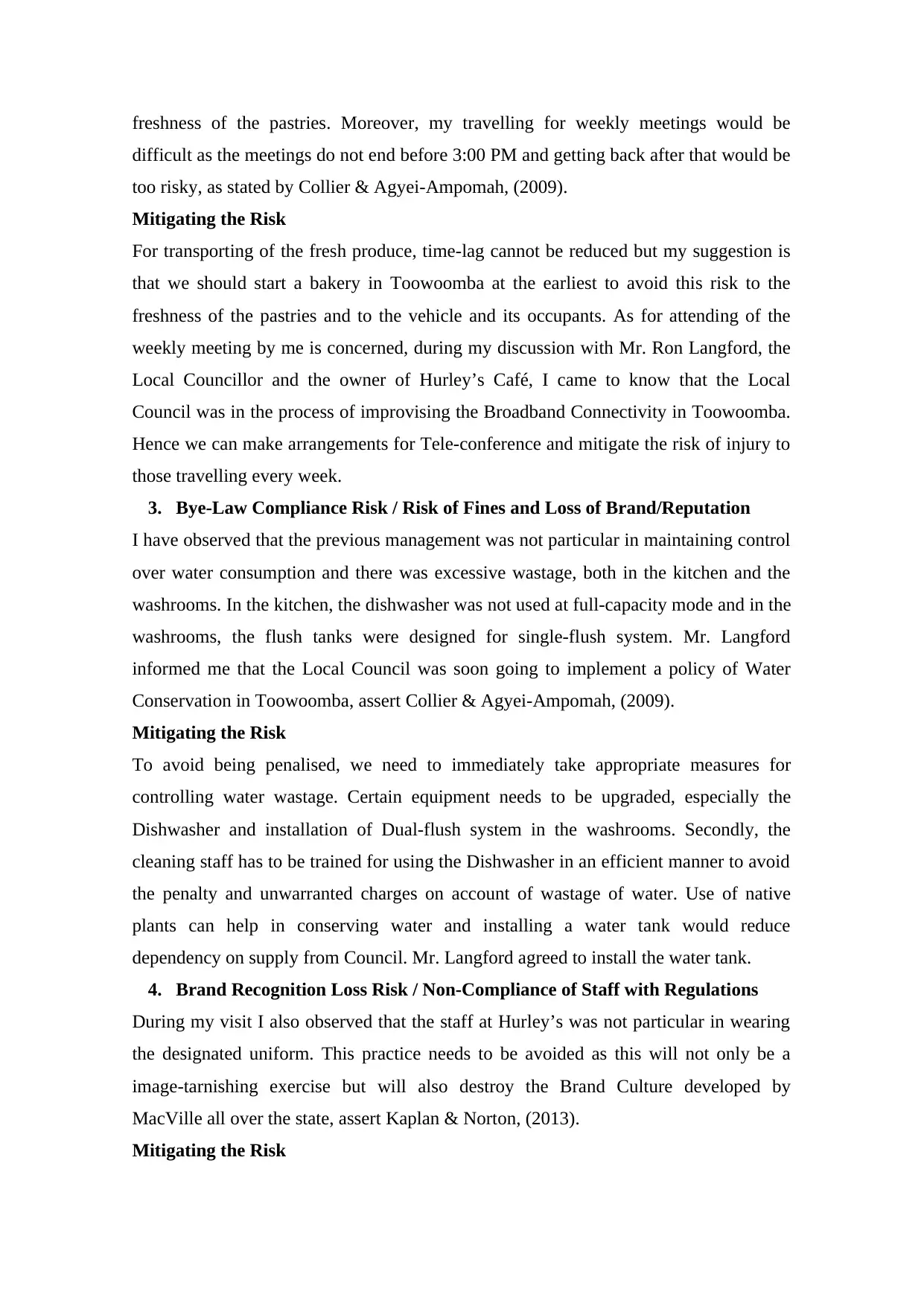
freshness of the pastries. Moreover, my travelling for weekly meetings would be
difficult as the meetings do not end before 3:00 PM and getting back after that would be
too risky, as stated by Collier & Agyei-Ampomah, (2009).
Mitigating the Risk
For transporting of the fresh produce, time-lag cannot be reduced but my suggestion is
that we should start a bakery in Toowoomba at the earliest to avoid this risk to the
freshness of the pastries and to the vehicle and its occupants. As for attending of the
weekly meeting by me is concerned, during my discussion with Mr. Ron Langford, the
Local Councillor and the owner of Hurley’s Café, I came to know that the Local
Council was in the process of improvising the Broadband Connectivity in Toowoomba.
Hence we can make arrangements for Tele-conference and mitigate the risk of injury to
those travelling every week.
3. Bye-Law Compliance Risk / Risk of Fines and Loss of Brand/Reputation
I have observed that the previous management was not particular in maintaining control
over water consumption and there was excessive wastage, both in the kitchen and the
washrooms. In the kitchen, the dishwasher was not used at full-capacity mode and in the
washrooms, the flush tanks were designed for single-flush system. Mr. Langford
informed me that the Local Council was soon going to implement a policy of Water
Conservation in Toowoomba, assert Collier & Agyei-Ampomah, (2009).
Mitigating the Risk
To avoid being penalised, we need to immediately take appropriate measures for
controlling water wastage. Certain equipment needs to be upgraded, especially the
Dishwasher and installation of Dual-flush system in the washrooms. Secondly, the
cleaning staff has to be trained for using the Dishwasher in an efficient manner to avoid
the penalty and unwarranted charges on account of wastage of water. Use of native
plants can help in conserving water and installing a water tank would reduce
dependency on supply from Council. Mr. Langford agreed to install the water tank.
4. Brand Recognition Loss Risk / Non-Compliance of Staff with Regulations
During my visit I also observed that the staff at Hurley’s was not particular in wearing
the designated uniform. This practice needs to be avoided as this will not only be a
image-tarnishing exercise but will also destroy the Brand Culture developed by
MacVille all over the state, assert Kaplan & Norton, (2013).
Mitigating the Risk
difficult as the meetings do not end before 3:00 PM and getting back after that would be
too risky, as stated by Collier & Agyei-Ampomah, (2009).
Mitigating the Risk
For transporting of the fresh produce, time-lag cannot be reduced but my suggestion is
that we should start a bakery in Toowoomba at the earliest to avoid this risk to the
freshness of the pastries and to the vehicle and its occupants. As for attending of the
weekly meeting by me is concerned, during my discussion with Mr. Ron Langford, the
Local Councillor and the owner of Hurley’s Café, I came to know that the Local
Council was in the process of improvising the Broadband Connectivity in Toowoomba.
Hence we can make arrangements for Tele-conference and mitigate the risk of injury to
those travelling every week.
3. Bye-Law Compliance Risk / Risk of Fines and Loss of Brand/Reputation
I have observed that the previous management was not particular in maintaining control
over water consumption and there was excessive wastage, both in the kitchen and the
washrooms. In the kitchen, the dishwasher was not used at full-capacity mode and in the
washrooms, the flush tanks were designed for single-flush system. Mr. Langford
informed me that the Local Council was soon going to implement a policy of Water
Conservation in Toowoomba, assert Collier & Agyei-Ampomah, (2009).
Mitigating the Risk
To avoid being penalised, we need to immediately take appropriate measures for
controlling water wastage. Certain equipment needs to be upgraded, especially the
Dishwasher and installation of Dual-flush system in the washrooms. Secondly, the
cleaning staff has to be trained for using the Dishwasher in an efficient manner to avoid
the penalty and unwarranted charges on account of wastage of water. Use of native
plants can help in conserving water and installing a water tank would reduce
dependency on supply from Council. Mr. Langford agreed to install the water tank.
4. Brand Recognition Loss Risk / Non-Compliance of Staff with Regulations
During my visit I also observed that the staff at Hurley’s was not particular in wearing
the designated uniform. This practice needs to be avoided as this will not only be a
image-tarnishing exercise but will also destroy the Brand Culture developed by
MacVille all over the state, assert Kaplan & Norton, (2013).
Mitigating the Risk
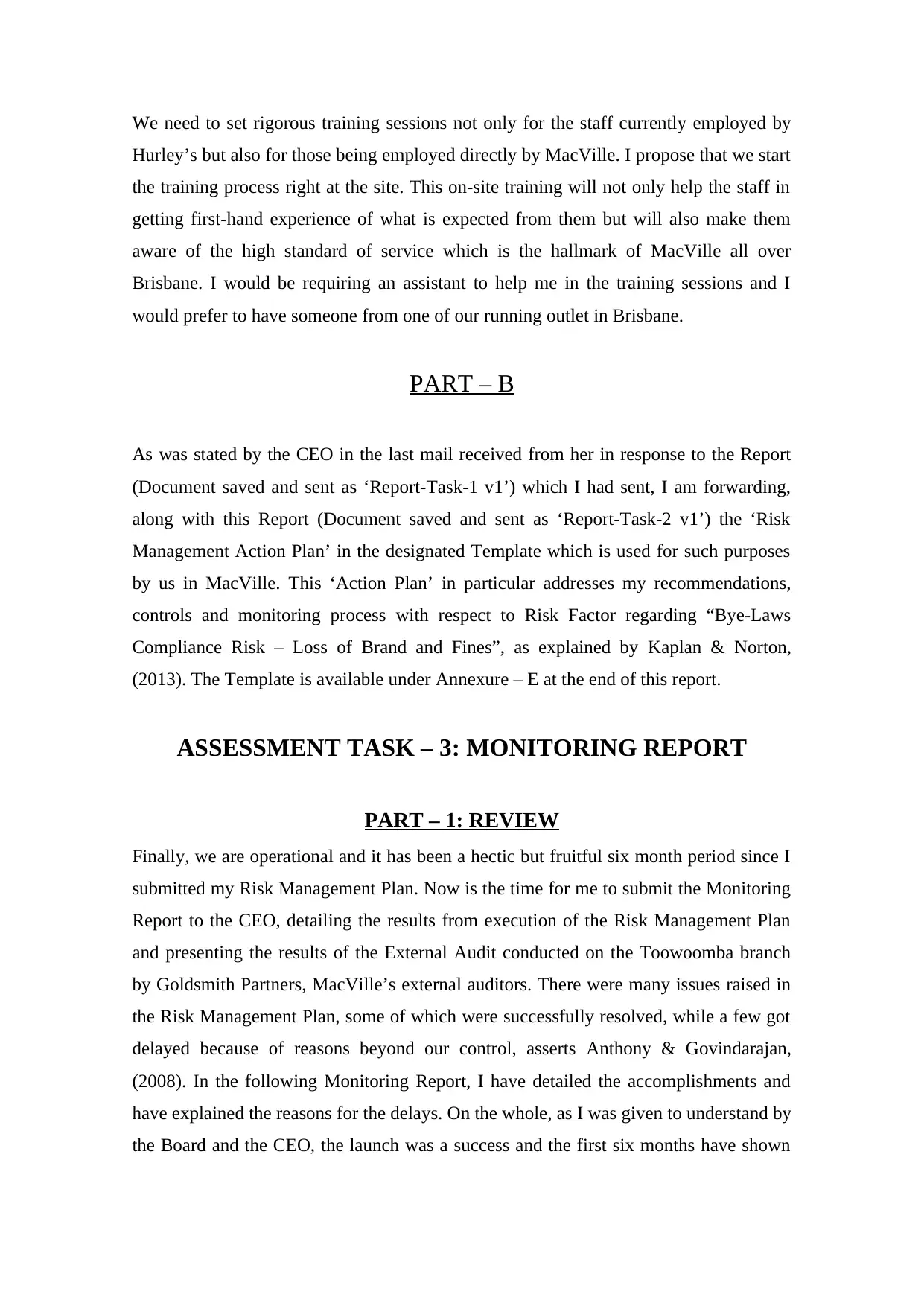
We need to set rigorous training sessions not only for the staff currently employed by
Hurley’s but also for those being employed directly by MacVille. I propose that we start
the training process right at the site. This on-site training will not only help the staff in
getting first-hand experience of what is expected from them but will also make them
aware of the high standard of service which is the hallmark of MacVille all over
Brisbane. I would be requiring an assistant to help me in the training sessions and I
would prefer to have someone from one of our running outlet in Brisbane.
PART – B
As was stated by the CEO in the last mail received from her in response to the Report
(Document saved and sent as ‘Report-Task-1 v1’) which I had sent, I am forwarding,
along with this Report (Document saved and sent as ‘Report-Task-2 v1’) the ‘Risk
Management Action Plan’ in the designated Template which is used for such purposes
by us in MacVille. This ‘Action Plan’ in particular addresses my recommendations,
controls and monitoring process with respect to Risk Factor regarding “Bye-Laws
Compliance Risk – Loss of Brand and Fines”, as explained by Kaplan & Norton,
(2013). The Template is available under Annexure – E at the end of this report.
ASSESSMENT TASK – 3: MONITORING REPORT
PART – 1: REVIEW
Finally, we are operational and it has been a hectic but fruitful six month period since I
submitted my Risk Management Plan. Now is the time for me to submit the Monitoring
Report to the CEO, detailing the results from execution of the Risk Management Plan
and presenting the results of the External Audit conducted on the Toowoomba branch
by Goldsmith Partners, MacVille’s external auditors. There were many issues raised in
the Risk Management Plan, some of which were successfully resolved, while a few got
delayed because of reasons beyond our control, asserts Anthony & Govindarajan,
(2008). In the following Monitoring Report, I have detailed the accomplishments and
have explained the reasons for the delays. On the whole, as I was given to understand by
the Board and the CEO, the launch was a success and the first six months have shown
Hurley’s but also for those being employed directly by MacVille. I propose that we start
the training process right at the site. This on-site training will not only help the staff in
getting first-hand experience of what is expected from them but will also make them
aware of the high standard of service which is the hallmark of MacVille all over
Brisbane. I would be requiring an assistant to help me in the training sessions and I
would prefer to have someone from one of our running outlet in Brisbane.
PART – B
As was stated by the CEO in the last mail received from her in response to the Report
(Document saved and sent as ‘Report-Task-1 v1’) which I had sent, I am forwarding,
along with this Report (Document saved and sent as ‘Report-Task-2 v1’) the ‘Risk
Management Action Plan’ in the designated Template which is used for such purposes
by us in MacVille. This ‘Action Plan’ in particular addresses my recommendations,
controls and monitoring process with respect to Risk Factor regarding “Bye-Laws
Compliance Risk – Loss of Brand and Fines”, as explained by Kaplan & Norton,
(2013). The Template is available under Annexure – E at the end of this report.
ASSESSMENT TASK – 3: MONITORING REPORT
PART – 1: REVIEW
Finally, we are operational and it has been a hectic but fruitful six month period since I
submitted my Risk Management Plan. Now is the time for me to submit the Monitoring
Report to the CEO, detailing the results from execution of the Risk Management Plan
and presenting the results of the External Audit conducted on the Toowoomba branch
by Goldsmith Partners, MacVille’s external auditors. There were many issues raised in
the Risk Management Plan, some of which were successfully resolved, while a few got
delayed because of reasons beyond our control, asserts Anthony & Govindarajan,
(2008). In the following Monitoring Report, I have detailed the accomplishments and
have explained the reasons for the delays. On the whole, as I was given to understand by
the Board and the CEO, the launch was a success and the first six months have shown
⊘ This is a preview!⊘
Do you want full access?
Subscribe today to unlock all pages.

Trusted by 1+ million students worldwide
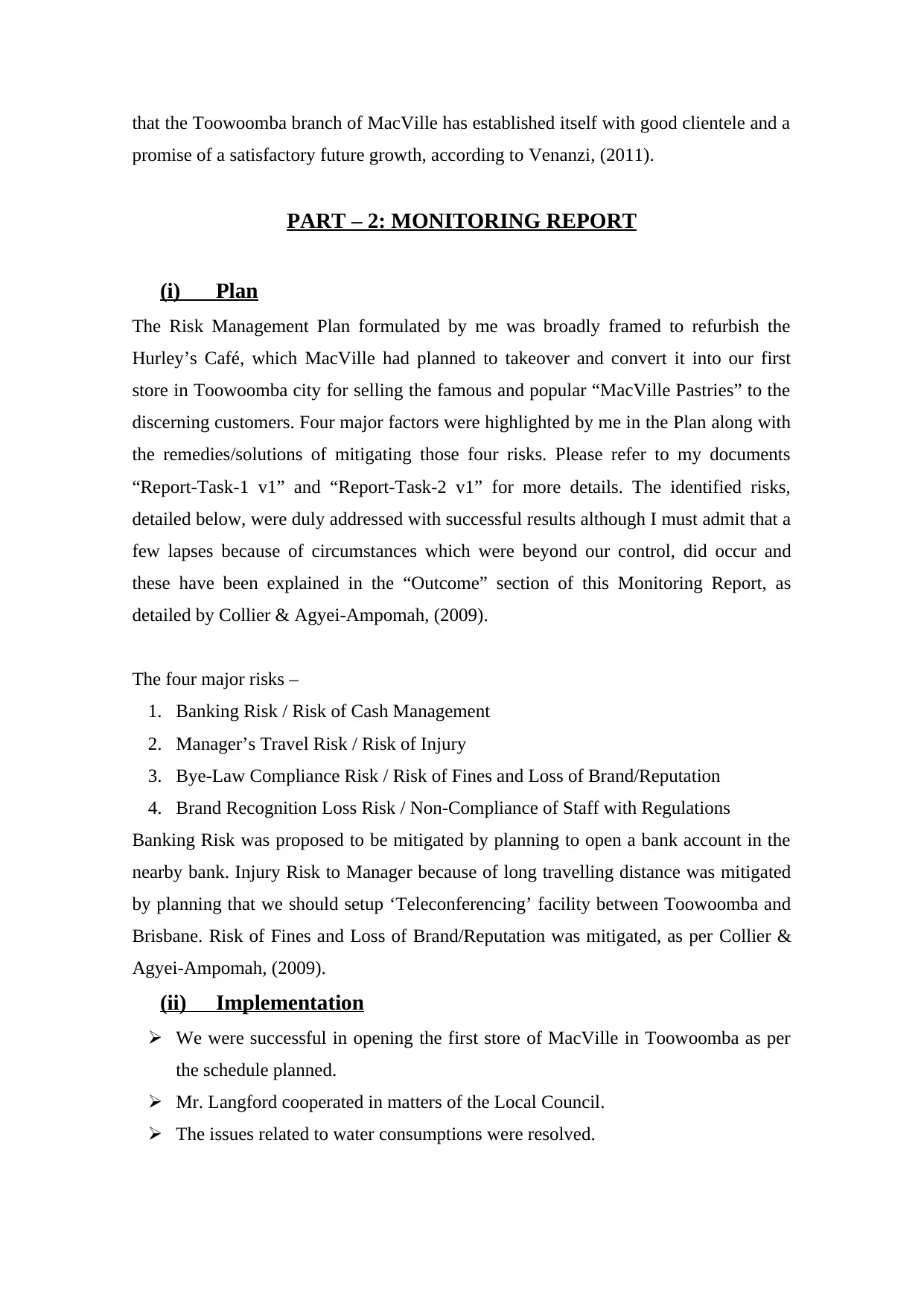
that the Toowoomba branch of MacVille has established itself with good clientele and a
promise of a satisfactory future growth, according to Venanzi, (2011).
PART – 2: MONITORING REPORT
(i) Plan
The Risk Management Plan formulated by me was broadly framed to refurbish the
Hurley’s Café, which MacVille had planned to takeover and convert it into our first
store in Toowoomba city for selling the famous and popular “MacVille Pastries” to the
discerning customers. Four major factors were highlighted by me in the Plan along with
the remedies/solutions of mitigating those four risks. Please refer to my documents
“Report-Task-1 v1” and “Report-Task-2 v1” for more details. The identified risks,
detailed below, were duly addressed with successful results although I must admit that a
few lapses because of circumstances which were beyond our control, did occur and
these have been explained in the “Outcome” section of this Monitoring Report, as
detailed by Collier & Agyei-Ampomah, (2009).
The four major risks –
1. Banking Risk / Risk of Cash Management
2. Manager’s Travel Risk / Risk of Injury
3. Bye-Law Compliance Risk / Risk of Fines and Loss of Brand/Reputation
4. Brand Recognition Loss Risk / Non-Compliance of Staff with Regulations
Banking Risk was proposed to be mitigated by planning to open a bank account in the
nearby bank. Injury Risk to Manager because of long travelling distance was mitigated
by planning that we should setup ‘Teleconferencing’ facility between Toowoomba and
Brisbane. Risk of Fines and Loss of Brand/Reputation was mitigated, as per Collier &
Agyei-Ampomah, (2009).
(ii) Implementation
We were successful in opening the first store of MacVille in Toowoomba as per
the schedule planned.
Mr. Langford cooperated in matters of the Local Council.
The issues related to water consumptions were resolved.
promise of a satisfactory future growth, according to Venanzi, (2011).
PART – 2: MONITORING REPORT
(i) Plan
The Risk Management Plan formulated by me was broadly framed to refurbish the
Hurley’s Café, which MacVille had planned to takeover and convert it into our first
store in Toowoomba city for selling the famous and popular “MacVille Pastries” to the
discerning customers. Four major factors were highlighted by me in the Plan along with
the remedies/solutions of mitigating those four risks. Please refer to my documents
“Report-Task-1 v1” and “Report-Task-2 v1” for more details. The identified risks,
detailed below, were duly addressed with successful results although I must admit that a
few lapses because of circumstances which were beyond our control, did occur and
these have been explained in the “Outcome” section of this Monitoring Report, as
detailed by Collier & Agyei-Ampomah, (2009).
The four major risks –
1. Banking Risk / Risk of Cash Management
2. Manager’s Travel Risk / Risk of Injury
3. Bye-Law Compliance Risk / Risk of Fines and Loss of Brand/Reputation
4. Brand Recognition Loss Risk / Non-Compliance of Staff with Regulations
Banking Risk was proposed to be mitigated by planning to open a bank account in the
nearby bank. Injury Risk to Manager because of long travelling distance was mitigated
by planning that we should setup ‘Teleconferencing’ facility between Toowoomba and
Brisbane. Risk of Fines and Loss of Brand/Reputation was mitigated, as per Collier &
Agyei-Ampomah, (2009).
(ii) Implementation
We were successful in opening the first store of MacVille in Toowoomba as per
the schedule planned.
Mr. Langford cooperated in matters of the Local Council.
The issues related to water consumptions were resolved.
Paraphrase This Document
Need a fresh take? Get an instant paraphrase of this document with our AI Paraphraser
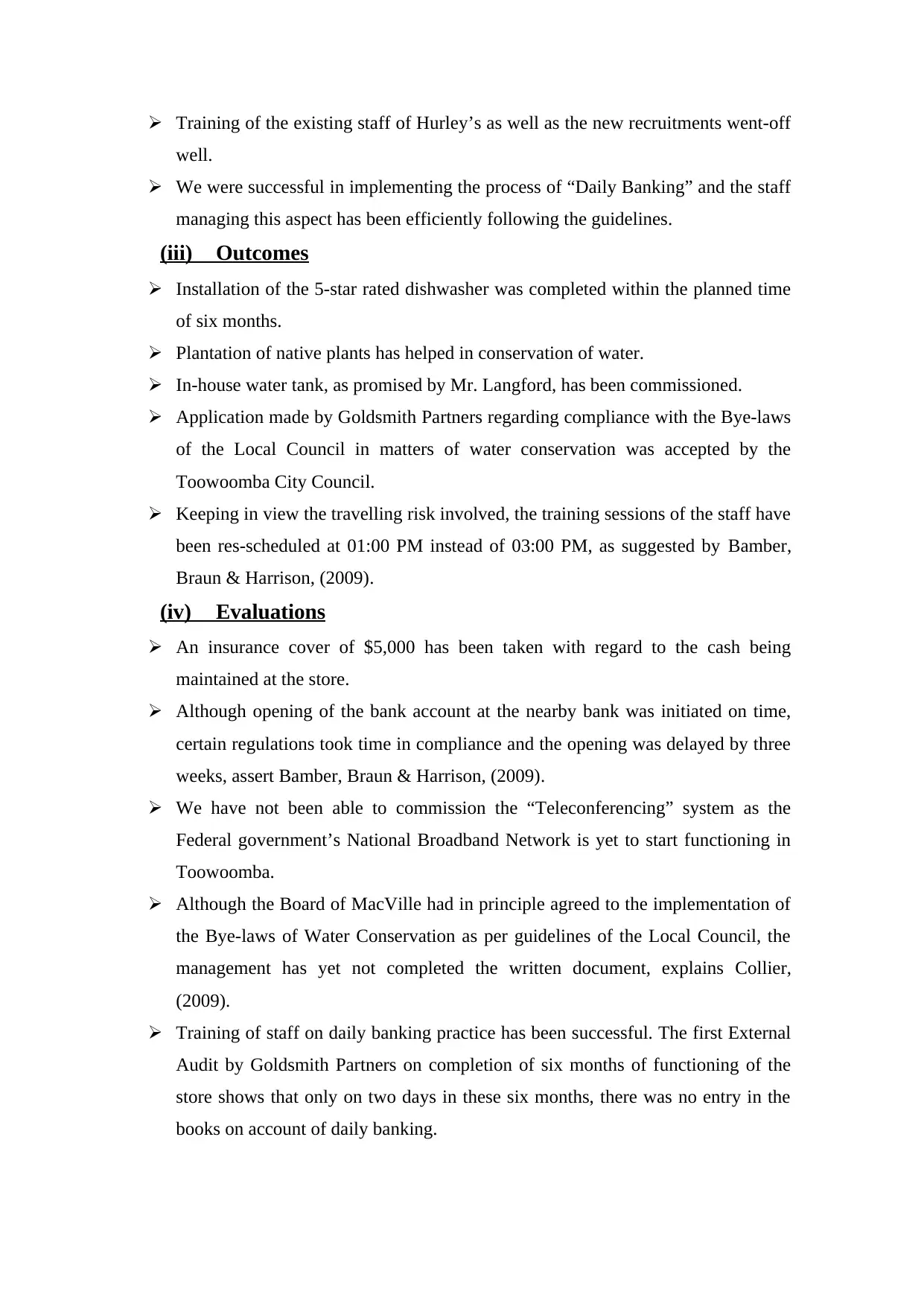
Training of the existing staff of Hurley’s as well as the new recruitments went-off
well.
We were successful in implementing the process of “Daily Banking” and the staff
managing this aspect has been efficiently following the guidelines.
(iii) Outcomes
Installation of the 5-star rated dishwasher was completed within the planned time
of six months.
Plantation of native plants has helped in conservation of water.
In-house water tank, as promised by Mr. Langford, has been commissioned.
Application made by Goldsmith Partners regarding compliance with the Bye-laws
of the Local Council in matters of water conservation was accepted by the
Toowoomba City Council.
Keeping in view the travelling risk involved, the training sessions of the staff have
been res-scheduled at 01:00 PM instead of 03:00 PM, as suggested by Bamber,
Braun & Harrison, (2009).
(iv) Evaluations
An insurance cover of $5,000 has been taken with regard to the cash being
maintained at the store.
Although opening of the bank account at the nearby bank was initiated on time,
certain regulations took time in compliance and the opening was delayed by three
weeks, assert Bamber, Braun & Harrison, (2009).
We have not been able to commission the “Teleconferencing” system as the
Federal government’s National Broadband Network is yet to start functioning in
Toowoomba.
Although the Board of MacVille had in principle agreed to the implementation of
the Bye-laws of Water Conservation as per guidelines of the Local Council, the
management has yet not completed the written document, explains Collier,
(2009).
Training of staff on daily banking practice has been successful. The first External
Audit by Goldsmith Partners on completion of six months of functioning of the
store shows that only on two days in these six months, there was no entry in the
books on account of daily banking.
well.
We were successful in implementing the process of “Daily Banking” and the staff
managing this aspect has been efficiently following the guidelines.
(iii) Outcomes
Installation of the 5-star rated dishwasher was completed within the planned time
of six months.
Plantation of native plants has helped in conservation of water.
In-house water tank, as promised by Mr. Langford, has been commissioned.
Application made by Goldsmith Partners regarding compliance with the Bye-laws
of the Local Council in matters of water conservation was accepted by the
Toowoomba City Council.
Keeping in view the travelling risk involved, the training sessions of the staff have
been res-scheduled at 01:00 PM instead of 03:00 PM, as suggested by Bamber,
Braun & Harrison, (2009).
(iv) Evaluations
An insurance cover of $5,000 has been taken with regard to the cash being
maintained at the store.
Although opening of the bank account at the nearby bank was initiated on time,
certain regulations took time in compliance and the opening was delayed by three
weeks, assert Bamber, Braun & Harrison, (2009).
We have not been able to commission the “Teleconferencing” system as the
Federal government’s National Broadband Network is yet to start functioning in
Toowoomba.
Although the Board of MacVille had in principle agreed to the implementation of
the Bye-laws of Water Conservation as per guidelines of the Local Council, the
management has yet not completed the written document, explains Collier,
(2009).
Training of staff on daily banking practice has been successful. The first External
Audit by Goldsmith Partners on completion of six months of functioning of the
store shows that only on two days in these six months, there was no entry in the
books on account of daily banking.
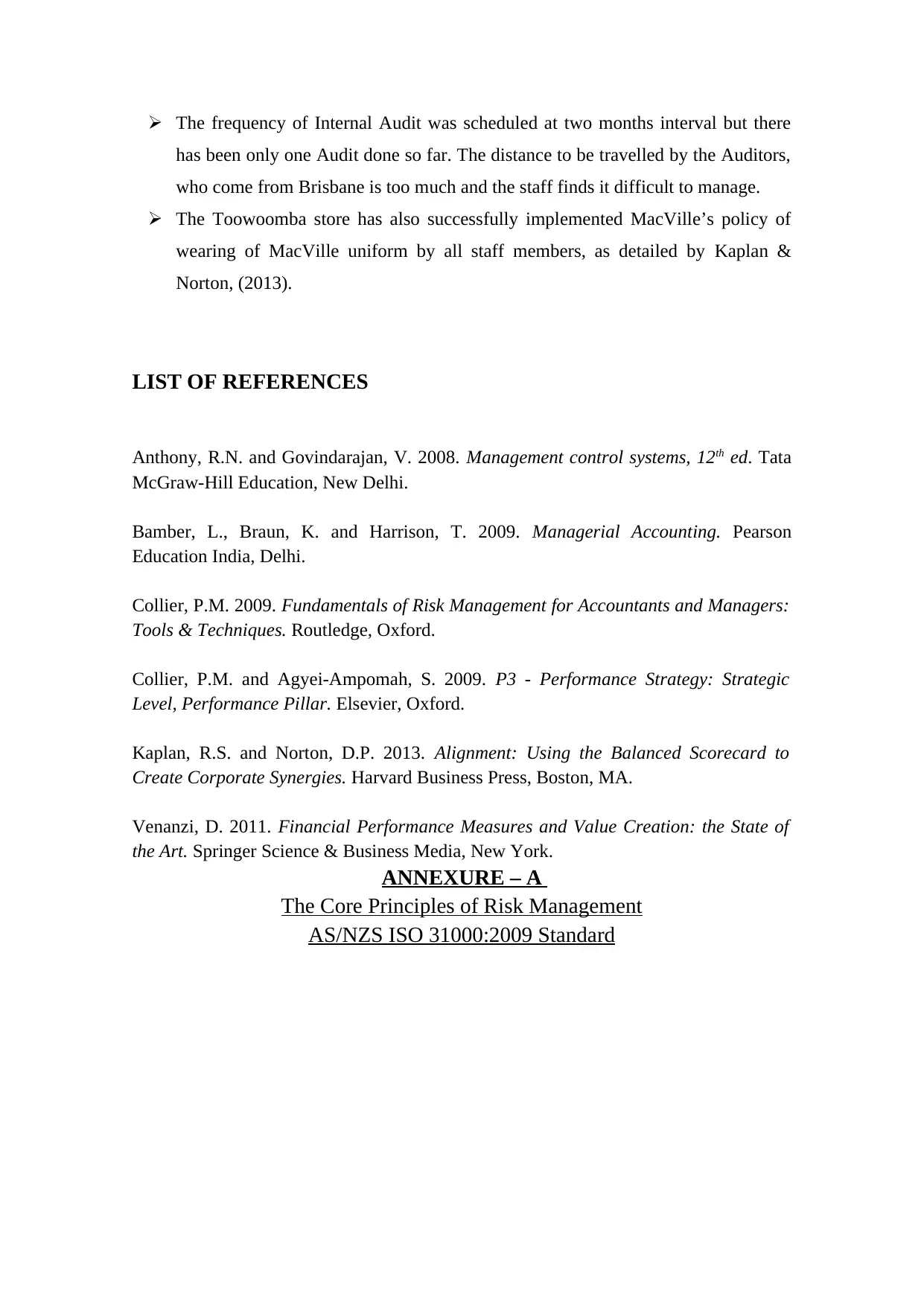
The frequency of Internal Audit was scheduled at two months interval but there
has been only one Audit done so far. The distance to be travelled by the Auditors,
who come from Brisbane is too much and the staff finds it difficult to manage.
The Toowoomba store has also successfully implemented MacVille’s policy of
wearing of MacVille uniform by all staff members, as detailed by Kaplan &
Norton, (2013).
LIST OF REFERENCES
Anthony, R.N. and Govindarajan, V. 2008. Management control systems, 12th ed. Tata
McGraw-Hill Education, New Delhi.
Bamber, L., Braun, K. and Harrison, T. 2009. Managerial Accounting. Pearson
Education India, Delhi.
Collier, P.M. 2009. Fundamentals of Risk Management for Accountants and Managers:
Tools & Techniques. Routledge, Oxford.
Collier, P.M. and Agyei-Ampomah, S. 2009. P3 - Performance Strategy: Strategic
Level, Performance Pillar. Elsevier, Oxford.
Kaplan, R.S. and Norton, D.P. 2013. Alignment: Using the Balanced Scorecard to
Create Corporate Synergies. Harvard Business Press, Boston, MA.
Venanzi, D. 2011. Financial Performance Measures and Value Creation: the State of
the Art. Springer Science & Business Media, New York.
ANNEXURE – A
The Core Principles of Risk Management
AS/NZS ISO 31000:2009 Standard
has been only one Audit done so far. The distance to be travelled by the Auditors,
who come from Brisbane is too much and the staff finds it difficult to manage.
The Toowoomba store has also successfully implemented MacVille’s policy of
wearing of MacVille uniform by all staff members, as detailed by Kaplan &
Norton, (2013).
LIST OF REFERENCES
Anthony, R.N. and Govindarajan, V. 2008. Management control systems, 12th ed. Tata
McGraw-Hill Education, New Delhi.
Bamber, L., Braun, K. and Harrison, T. 2009. Managerial Accounting. Pearson
Education India, Delhi.
Collier, P.M. 2009. Fundamentals of Risk Management for Accountants and Managers:
Tools & Techniques. Routledge, Oxford.
Collier, P.M. and Agyei-Ampomah, S. 2009. P3 - Performance Strategy: Strategic
Level, Performance Pillar. Elsevier, Oxford.
Kaplan, R.S. and Norton, D.P. 2013. Alignment: Using the Balanced Scorecard to
Create Corporate Synergies. Harvard Business Press, Boston, MA.
Venanzi, D. 2011. Financial Performance Measures and Value Creation: the State of
the Art. Springer Science & Business Media, New York.
ANNEXURE – A
The Core Principles of Risk Management
AS/NZS ISO 31000:2009 Standard
⊘ This is a preview!⊘
Do you want full access?
Subscribe today to unlock all pages.

Trusted by 1+ million students worldwide
1 out of 16
Related Documents
Your All-in-One AI-Powered Toolkit for Academic Success.
+13062052269
info@desklib.com
Available 24*7 on WhatsApp / Email
![[object Object]](/_next/static/media/star-bottom.7253800d.svg)
Unlock your academic potential
Copyright © 2020–2025 A2Z Services. All Rights Reserved. Developed and managed by ZUCOL.




